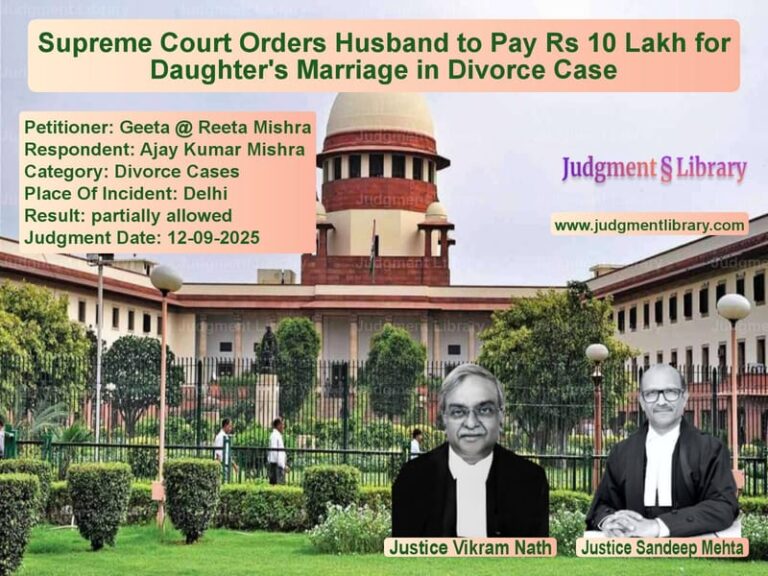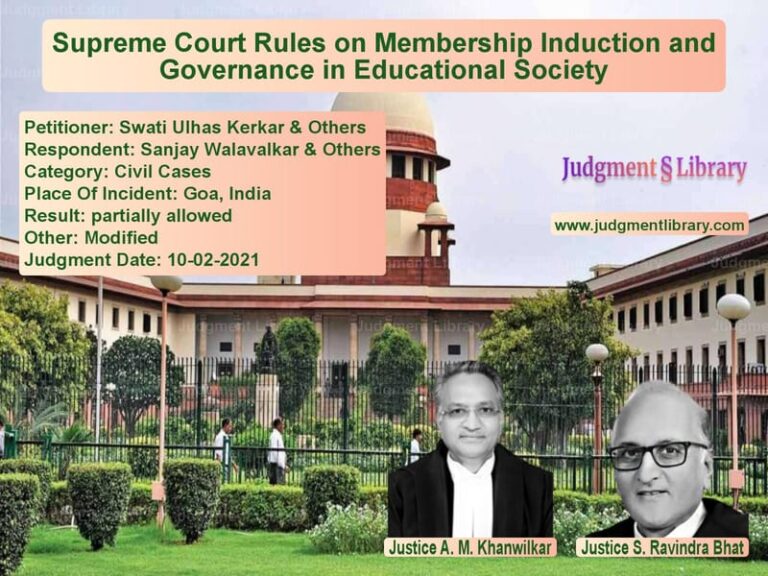Nagpur Improvement Trust vs. Sheela Tikhe: Legal Battle Over Land Re-Allotment
The legal dispute between the Nagpur Improvement Trust (NIT) and Sheela Ramchandra Tikhe revolves around the re-allotment of land that was initially acquired for a public project. This case highlights the intricacies of land acquisition, re-allotment policies, and statutory limitations. The Supreme Court was called upon to decide whether the respondent was entitled to an additional allotment of 20.61 acres of land based on prior agreements and policies. The judgment, delivered by the Supreme Court, ultimately ruled in favor of the Nagpur Improvement Trust, dismissing the claims of the respondent.
The case stems from the acquisition of 44.61 acres of land under the Drainage and Sewerage Scheme Part-II. The respondent, Sheela Tikhe, contended that she was entitled to the entire 44.61 acres, while the NIT argued that only 24 acres were allotted under the applicable laws. The legal battle traversed multiple courts, culminating in the Supreme Court’s decision.
Background of the Case
The Nagpur Improvement Trust was established under the Nagpur Improvement Trust Act, 1936. It acquired the disputed land through a notification issued on November 27, 1953, under Section 39 of the Act. An award determining compensation at Rs. 23,500 was issued on December 31, 1962, which was paid to the respondent. With possession taken by the Trust, the land legally vested with it.
In 1968, the Board of NIT resolved to offer re-allotment of acquired land to the original owners on lease terms. Based on this policy, the respondent applied for re-allotment of the entire 44.61 acres in 1975. The Trust initially agreed but later revised its decision, offering only 24 acres in 1982. The respondent disputed this limitation and sought legal recourse.
Petitioner’s Arguments
The Nagpur Improvement Trust, represented by its senior counsel, made the following key arguments:
- The respondent’s suit was barred by limitation as the cause of action arose in 1982, yet the suit was filed in 1989.
- After the enforcement of the Nagpur Improvement Trust Land Disposal Rules, 1983, there was no provision allowing for direct re-allotment of land.
- Under the 1983 Rules, the only permissible modes of land disposal were public auction, tenders, or government allotment.
- The High Court erred in applying outdated rules when the new legal framework superseded earlier provisions.
Respondent’s Arguments
Senior counsel Mukul Rohatgi, representing the respondent, countered with the following points:
- The original allotment of 44.61 acres was promised in 1975, prior to the enforcement of the 1983 Rules.
- The refusal to allot the remaining land occurred in 1989 when the lease for only 24 acres was executed, making the suit within the limitation period.
- The new rules should not apply retroactively to an agreement made under the 1955 Rules.
- The Trust had already agreed to re-allot the land, making it a case of enforcement rather than a fresh claim.
Supreme Court’s Findings
The Supreme Court ruled in favor of the Nagpur Improvement Trust, overturning the High Court’s ruling and dismissing the respondent’s claims. The key findings included:
- Legal Standing of the Re-Allotment: The Court observed that “There was never any firm allotment of 44.61 acres to the plaintiff giving any indefeasible right of allotment.”
- Application of the 1983 Rules: The Court ruled that “After the enforcement of the 1983 Rules, which substantially changed the manner of allotment, no land could be allotted in disregard of the statutory provisions.”
- Finality of Land Acquisition: The judgment reinforced that “Once the land is acquired for a public purpose, it vests in the acquiring body, and the previous owner has no automatic right to reclaim it.”
- Barred by Limitation: The Court found that the claim was filed much later than the permissible timeframe.
Impact and Legal Precedents
This judgment has significant implications for land acquisition and re-allotment policies. It reinforces the principle that acquired land vests permanently in the acquiring authority unless specific provisions dictate otherwise. It also upholds the integrity of statutory limitations, ensuring that disputes are raised within the prescribed timeframe.
By aligning with prior Supreme Court rulings, such as State of Kerala vs. M. Bhaskar Pillai and Sulochana Chandrakant Galande vs. Pune Municipal Transport, the Court reiterated that erstwhile landowners cannot reclaim property once acquired for public purposes.
The case underscores the importance of adhering to statutory frameworks and the limitations imposed by law. The decision serves as a guiding precedent for future disputes involving land re-allotment and public acquisitions.
Petitioner Name: Nagpur Improvement Trust.Respondent Name: Sheela Ramchandra Tikhe.Judgment By: Justice A.K. Sikri, Justice Ashok Bhushan.Place Of Incident: Nagpur.Judgment Date: 31-10-2018.
Don’t miss out on the full details! Download the complete judgment in PDF format below and gain valuable insights instantly!
Download Judgment: Nagpur Improvement T vs Sheela Ramchandra Ti Supreme Court of India Judgment Dated 31-10-2018.pdf
Direct Downlaod Judgment: Direct downlaod this Judgment
See all petitions in Property Disputes
See all petitions in Specific Performance
See all petitions in Damages and Compensation
See all petitions in Judgment by A.K. Sikri
See all petitions in Judgment by Ashok Bhushan
See all petitions in dismissed
See all petitions in supreme court of India judgments October 2018
See all petitions in 2018 judgments
See all posts in Civil Cases Category
See all allowed petitions in Civil Cases Category
See all Dismissed petitions in Civil Cases Category
See all partially allowed petitions in Civil Cases Category







